Chris Howard's Blog, page 18
June 17, 2022
The moon is bright and the clouds are fast. So, I’ve been...
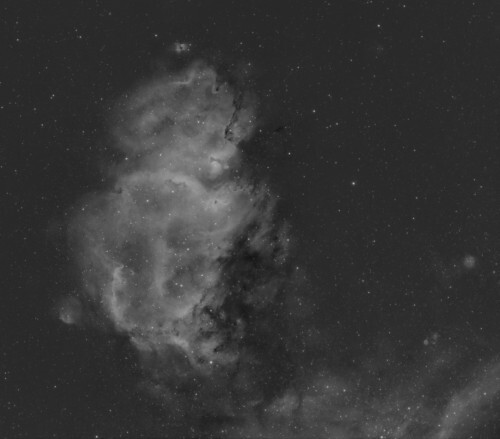
The moon is bright and the clouds are fast. So, I’ve been goofing around with hardware, updated NINA and plugins, getting ready for the next clear night. It’s raining right now. I was looking at some narrowband data for Sharpless 2-199 (Soul Nebula in Cassiopeia) I captured late last year and reprocessed the Ha data. I am especially fascinated by the differences in depth and darkness between the background and the bands of dust and interstellar gasses that twist in front of the Soul Nebula, between us and the high-energy emission of the towering clouds of hydrogen beyond. Someone commented (I think on AstroBin) on another image of mine with similar properties—that I needed to bring up the black point, that the night sky is black. But why? Who says so? The data says the background isn’t as dark as the dust, so why would I want to lose that difference?
June 11, 2022
A shot of the moon through the trees. I really wanted to capture...
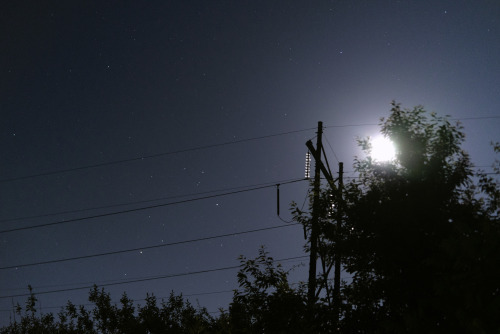
A shot of the moon through the trees. I really wanted to capture the moonlight through the glass insulators on the transmission lines. About a third of the way in from bottom left is the variable double star Antares (alpha Scorpii) in the constellation Scorpius. Antares is also part of the Rho Ophiuchi Cloud Complex, one of the most colorful and beautiful regions in the night sky. Unfortunately, what you see here, Antares at 20° is about as high as it will get in the sky. We’re just too damn north.
The famous “Pillars of Creation” from the classic...
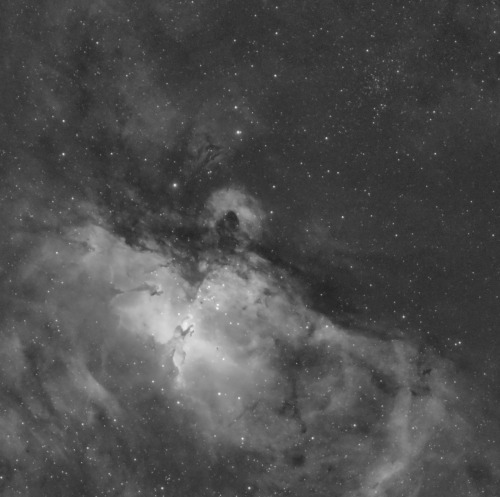
The famous “Pillars of Creation” from the classic Hubble (HST) image are in the core of the Eagle Nebula (Messier 16). Notes: 36 x 240 second subs staked in DSS, processed in PS2022. William Optics SpaceCat 51 Apo Refractor 250mm f/4.9, Astronomik 6nm Ha filter, ZWO ASI1600MM-Pro monochrome camera, Sky-Watcher EQ6-R Pro equatorial mount. It’s no Hubble image, but still crazy what I can capture with a 250mm refractor from my backyard in New Hampshire. Here’s the famous “Pillars of Creation” Hubble image: https://upload.wikimedia.org/wikipedia/commons/6/68/Pillars_of_creation_2014_HST_WFC3-UVIS_full-res_denoised.jpg
June 8, 2022
IC 1318, the “Sadr Region”, at the heart of the...
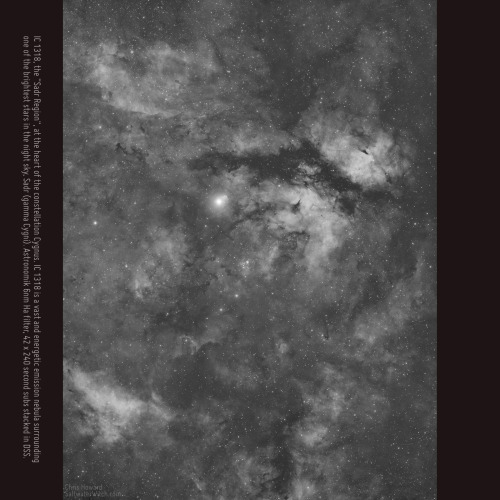
IC 1318, the “Sadr Region”, at the heart of the constellation Cygnus. IC 1318 is a vast and energetic emission nebula surrounding one of the brightest stars in the night sky, Sadr (γ Cygni). Astronomik 6nm Ha filter, 42 x 240 second subs stacked in DSS.
June 7, 2022
It was a night of dodging clouds and narrowband...
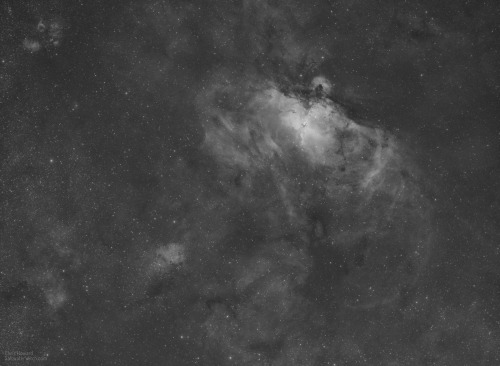
It was a night of dodging clouds and narrowband imaging…that was Sunday night into Monday morning. Here’s one from the session: the Hydrogen-alpha image set of Messier 16 (Eagle Nebula, Star Queen Nebula) along with a handful of Sharpless Catalogue objects, including the emission nebula Sh2-53 at the top left. Notes: William Optics SpaceCat 51 Apo Refractor 250mm f/4.9, Astronomik 6nm Ha filter, ZWO ASI1600MM-Pro monochrome camera, Sky-Watcher EQ6-R Pro equatorial mount. More of my astro stuff: https://SaltwaterWitch.com
June 6, 2022
Here’s last night’s astro-imaging session captured...
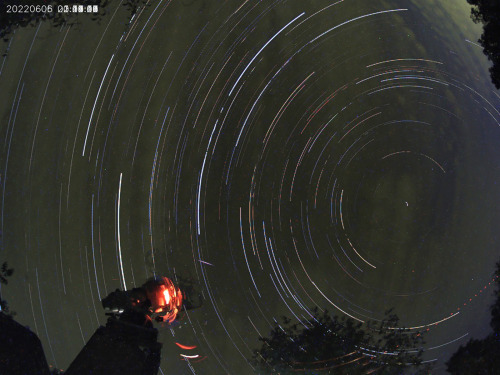
Here’s last night’s astro-imaging session captured in one image. You can see a couple batches of clouds swept through at different times. The AllSky cam, sitting on a concrete block next to the telescope, takes pictures all night long with a 6mm super-wide-angle lens. In the morning there are a bunch of time-lapse images of the night, and in this “star trails” image, all the separate images from the night are merged into one image, showing the earth’s rotation. You can also see some red LED arcs (bottom left) showing where my telescope slewed or tracked a target across the sky. That bright quarter-circle in the center of the rings of star trails is Polaris, the “North Star”, alpha Ursae Minoris. Polaris is a few degrees off the NCP–North Celestial Pole, a point in space that marks our planet’s rotation in the northern hemisphere (you’ll see the SCP in the southern hemisphere, although there isn’t a bright star nearby like Polaris). Here’s how to think about this: if you extended an imaginary line out from Earth’s axis of rotation and you’re north of the equator, the line would end, from our perspective, right there at the NCP. You can see that the star Polaris isn’t dead-on with the NCP because it too rotates around it.
June 5, 2022
IC 1396 (Elephant’s Trunk Nebula) in Cepheus - I captured...
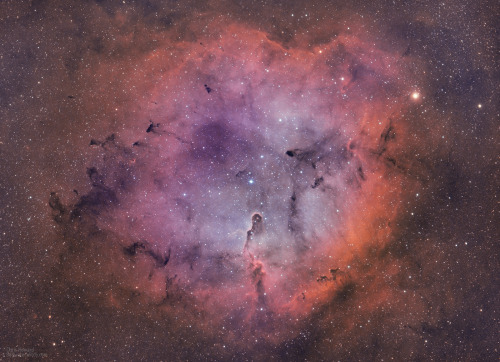
IC 1396 (Elephant’s Trunk Nebula) in Cepheus - I captured another four hours of data last night, this time in OIII, and here’s the processed version with combined Hydrogen-alpha and Oxygen 3 data. Oxygen is in blue (~504nm) and Ha (~656nm) is in red. Imaging Notes: 64 x 240 second subs in Hydrogen-alpha, 72 x 240 second subs in OIII, stacked in DSS, over 9 hours of data. Gear: William Optics SpaceCat51 Refractor, ZWO ASI1600MM-Pro mono camera, Antlia Pro 3nm Ha, OIII filters, Sky-Watcher EQ6R Pro equatorial mount.
May 30, 2022
Wide-field testing in the backyard - One of my tests from last...
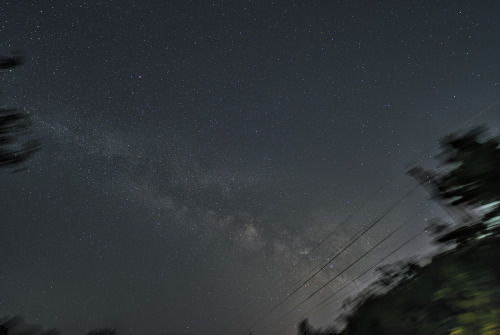
Wide-field testing in the backyard - One of my tests from last night. This is 55 stacked 10 second exposures at ISO 3200 on the Sony A7s and the Irix 15mm f/2.4. (Stacked in Affinity Photo). The iOptron SkyGuider Pro has the camera locked on the stars and you can see the trees and transmission lines in the foreground flying by. That’s the rotation of the earth in the roughly 10 minutes I spent taking 55 exposures.
May 29, 2022
Setting up the iOptron SkyGuider Pro with the Sony A7s + Irix...
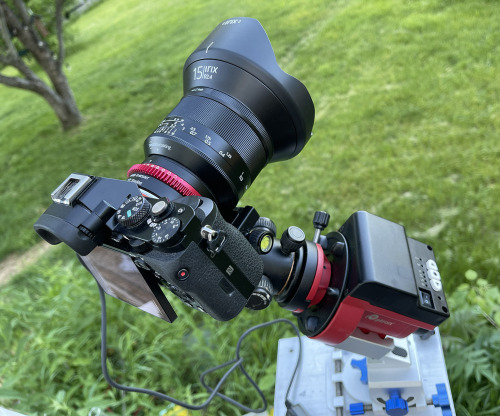
Setting up the iOptron SkyGuider Pro with the Sony A7s + Irix 15mm f/2.4. I’m just doing some widefield star tracking tests tonight–and not for a while. The Milky Way won’t hit 30° in the east until 11pm.
May 26, 2022
The Flaming Star Nebula (IC 405, SH 2-229, Caldwell 31) is a...
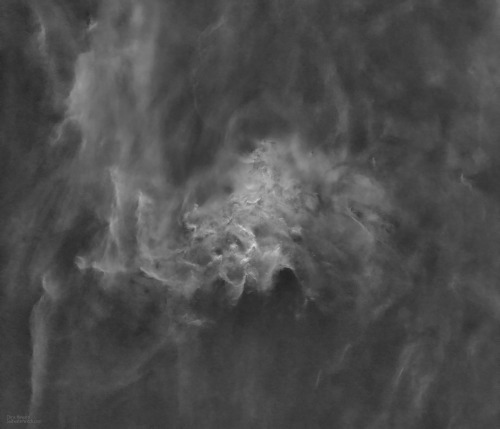
The Flaming Star Nebula (IC 405, SH 2-229, Caldwell 31) is a massive emission nebula and reflection nebula, 1500 lightyears away in the constellation Auriga. IC 405 is about 5 lightyears across, so that’s roughly 30 trillion miles (47 trillion kilometers) of dense clouds of ionized hydrogen. With the stars in the field of view removed (or just de-emphasized) you can really see the motion in the clouds of hydrogen and interstellar dust. It is the intense radiation and stellar winds from energetic stars (especially AE Aurigae, a rather large blue O-type main sequence star) that drive these clouds through space, but that motion and the complexity of the cloud structures is not as easy to see with all the stars in the way. Imaging Notes: 60 x 240sec subs stacked in DSS. William Optics GT81 Apo refractor, 6nm Astronomik Ha filter, ZWO ASI 1600MM-Pro monochrome camera. Star removal: StarNet++



